|
A Thousand Years of Skyscrapers
OK, I know, nine hundred and forty-seven, and they weren't. But it will be and, for their time, they were...

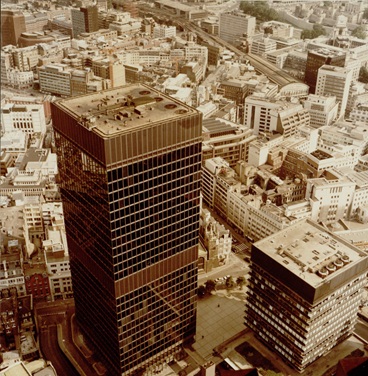
 When it was built in the 1960s at the junction of St Mary Axe and Leadenhall Street, the state-of-the-art 24-floor Commercial Union building, St Helen's Undershaft, was the second tallest office building in the City of London at 118 metres, and just a little taller than St Paul's Cathedral.
At the time, the south bank of the Thames opposite the Tower of London was still lined with grey warehouses.
(*Photo left, St Helen's c.1970, courtesy of Aviva)
When it was built in the 1960s at the junction of St Mary Axe and Leadenhall Street, the state-of-the-art 24-floor Commercial Union building, St Helen's Undershaft, was the second tallest office building in the City of London at 118 metres, and just a little taller than St Paul's Cathedral.
At the time, the south bank of the Thames opposite the Tower of London was still lined with grey warehouses.
(*Photo left, St Helen's c.1970, courtesy of Aviva)
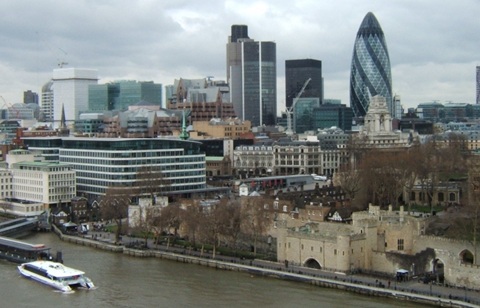
 Now St Helen's is about to set a record as the tallest tower ever taken down in London, to be replaced (in due course) by 73-storey 1 Undershaft, the City's equivalent of the south-bank Shard.
(The only taller building ever dismantled in London, at 150 metres, was Old St Paul's Cathedral after the Great Fire of London.)
Now St Helen's is about to set a record as the tallest tower ever taken down in London, to be replaced (in due course) by 73-storey 1 Undershaft, the City's equivalent of the south-bank Shard.
(The only taller building ever dismantled in London, at 150 metres, was Old St Paul's Cathedral after the Great Fire of London.)
The photo above right was taken from London Bridge, on a Fellowship visit in 2008. The Tower of London is visible bottom right while, at 180 metres, the 41-floor Gherkin (30 St Mary Axe, formerly the Swiss Re Building), built on the site of the former Baltic Exchange, already looms over its gloomy neighbour, St Helen's.
The tallest building in this photo is actually London's first skyscraper, the NatWest Tower (Tower 42), its strange bald top standing at 183 metres. This was the UK's tallest building, until overtaken by Canary Wharf's iconic 50-floor One Canada Square at 235 metres in 1991.
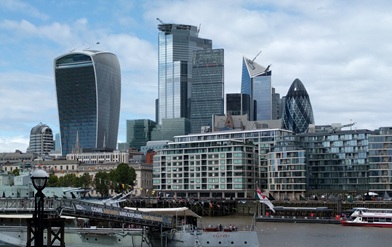
 In the photo on the left, taken across HMS Belfast from The Queen's Walk between London Bridge and Tower Bridge in 2019,
the Walkie Talkie (at 20 Fenchurch Street, curved so as not to obstruct views of St Paul's)
has taken up its dominating position, and Horizon 22 (22 Bishopsgate), the tallest building in the City, is nearing completion. St Helen's and NatWest have been lost in the crowd.
In the photo on the left, taken across HMS Belfast from The Queen's Walk between London Bridge and Tower Bridge in 2019,
the Walkie Talkie (at 20 Fenchurch Street, curved so as not to obstruct views of St Paul's)
has taken up its dominating position, and Horizon 22 (22 Bishopsgate), the tallest building in the City, is nearing completion. St Helen's and NatWest have been lost in the crowd.
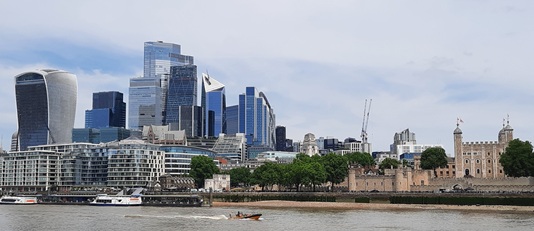
 On a couple of Fellowship walks along the river this summer, we've caught up with the results of a Tall Building boom in the aftermath of Covid. In a photo taken slightly to the east of our previous visit, the skyscrapers seem to be jostling for position. Even the beautiful Gherkin has been elbowed to the back, with just a little sliver visible at the right-hand side of its shorter neighbour, 40 Leadenhall Street.
For the moment, however, the Tower of London seems to be holding its own.
On a couple of Fellowship walks along the river this summer, we've caught up with the results of a Tall Building boom in the aftermath of Covid. In a photo taken slightly to the east of our previous visit, the skyscrapers seem to be jostling for position. Even the beautiful Gherkin has been elbowed to the back, with just a little sliver visible at the right-hand side of its shorter neighbour, 40 Leadenhall Street.
For the moment, however, the Tower of London seems to be holding its own.
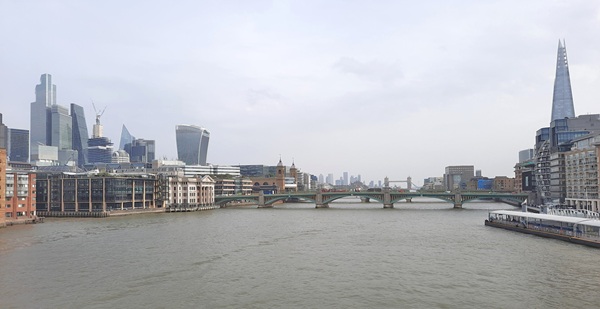
 The City of London is situated on the north bank of the Thames but the Shard (started shortly after our first photo above and completed in 2012) sits astride London Bridge Station in Southwark, so in other photos here it is out of shot behind the camera.
In this final shot, taken on a misty morning in October 2023 from the Millenium Bridge, opposite St Paul's, the Shard is visible on the right hand side. Bankside pier is in the immediate right foreground, followed by Southwark Bridge, with Cannon Street Bridge and London Bridge partially obscured behind, then the distinctive shape of Tower Bridge and, far away in the distant haze, Canary Wharf with the pointed top of One Canada Square.
The City of London is situated on the north bank of the Thames but the Shard (started shortly after our first photo above and completed in 2012) sits astride London Bridge Station in Southwark, so in other photos here it is out of shot behind the camera.
In this final shot, taken on a misty morning in October 2023 from the Millenium Bridge, opposite St Paul's, the Shard is visible on the right hand side. Bankside pier is in the immediate right foreground, followed by Southwark Bridge, with Cannon Street Bridge and London Bridge partially obscured behind, then the distinctive shape of Tower Bridge and, far away in the distant haze, Canary Wharf with the pointed top of One Canada Square.
If you click on any photo on this page, you should be able to see a more detailed version.

The history of tall structures in London began with construction of the 27-metre (89ft) White Tower, part of the Tower of London, in 1078.
The first structure to exceed 100 metres (328ft) was the Old St Paul's Cathedral, completed in 1310 at a height of 150 metres (492ft). St Paul's was briefly the world's tallest structure until 1311, when it was surpassed by Lincoln Cathedral. (It regained the title when the spire of Lincoln Cathedral fell in 1549.)
When St Paul's was damaged by the Great Fire of London in 1666, the title of the tallest structure in London passed to Southwark Cathedral, standing at a height of 50 metres (164ft). No subsequent structure in London topped 100 metres until 1710, when the current St Paul's Cathedral was completed at 111 metres (364ft), then becoming London's tallest building.
As of 2025, there are 125 buildings or structures at least 100 metres (328ft) tall in the Greater London area, with 26 of these being in the City of London and 32 in the Canary Wharf / Isle of Dogs district. The Greater London metropolitan area contains the second most skyscrapers of any city in Europe after Moscow. There are 42 skyscrapers in Greater London that reach at least 150 metres (492ft), the tallest being The Shard near London Bridge at 309.6 metres.

|

